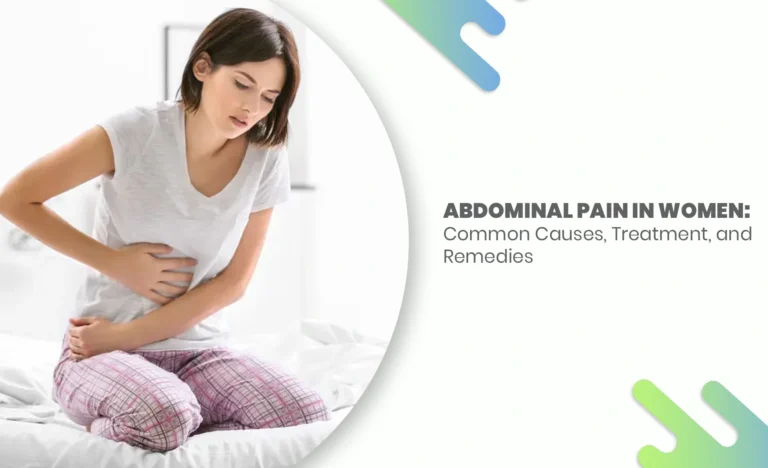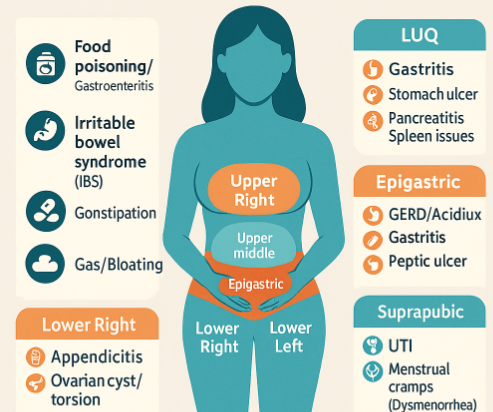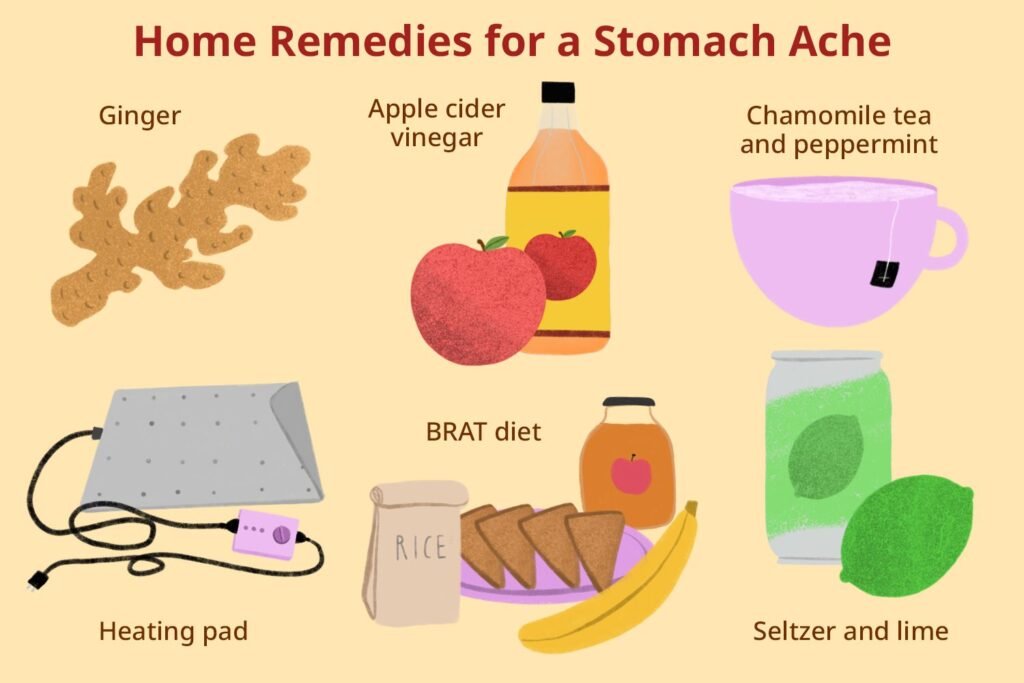Abdominal Pain in Women: Common Causes, Treatment, and Remedies

Abdominal pain in women is one of the most frequent yet complex health complaints doctors encounter. From mild female stomach pain linked to normal menstrual cramps to more serious conditions like appendicitis symptoms in women, ectopic pregnancy pain, or even ovarian cysts pain, the spectrum of possible causes is wide and sometimes confusing.
What makes women’s abdominal discomfort especially challenging is that it can stem from a variety of overlapping issues, gynecological causes such as endometriosis symptoms, uterine fibroids, or pelvic inflammatory disease; digestive problems like gastritis symptoms, stomach ulcer symptoms, irritable bowel syndrome, or food poisoning abdominal pain; and urinary or organ-related issues including urinary tract infection, kidney stones in women, or gallbladder pain in females. Each presents differently, whether as lower abdominal pain in females, upper abdominal pain in women, or more generalized bloating and gas pain.
Identifying the right cause early is critical. A sharp, sudden episode of emergency abdominal pain may require immediate abdominal pain diagnosis with tools like ultrasound for pelvic pain, blood tests for abdominal pain, or even a CT scan abdomen. On the other hand, chronic patterns such as cramping pain in women, chronic pelvic pain, or nausea with abdominal pain may point to long-term conditions that need ongoing pain management for women or specialized dysmenorrhea treatment.
The key takeaway? Not all post-meal abdominal pain, burning stomach sensation, or pain during menstruation is harmless. Sometimes home remedies for stomach pain, heat therapy for abdominal pain, or natural pain relief through dietary changes, probiotics for digestive health, and stress management are enough. But in other cases, proper medical examination, prescription pain treatment, or even surgical care becomes necessary.
From simple abdominal pain relief strategies to advanced treatment protocols, understanding the difference between minor discomfort and a potentially life-threatening issue can make all the difference in women’s health.
Understanding Abdominal Pain in Women
When discussing abdominal pain in women, it’s important to distinguish between abdominal pain and pelvic pain. Abdominal pain often refers to discomfort anywhere between the chest and groin, while pelvic pain causes are more specific to the lower abdomen, often linked to the reproductive organs. For example, lower abdominal pain in females is commonly related to menstrual cramps, ovulation pain, or endometriosis symptoms, whereas upper abdominal pain in women may point to gallbladder pain in females, stomach ulcer symptoms, or acid reflux in women.
The way symptoms appear can vary significantly. Some women experience sharp abdominal pain that comes on suddenly, such as in appendicitis symptoms in women or ectopic pregnancy pain, while others struggle with chronic pelvic pain or recurring cramping pain in women related to dysmenorrhea treatment or irritable bowel syndrome. The intensity may range from mild bloating and discomfort to severe nausea with abdominal pain, and the duration can be short-lived, like food poisoning abdominal pain, or long-lasting, such as with inflammatory bowel disease or uterine fibroids.
Recognizing when women’s abdominal discomfort signals a more serious health issue is crucial. Persistent post-meal abdominal pain, unexplained burning stomach sensation, or diarrhea with abdominal cramps may require a formal abdominal pain diagnosis. Doctors may recommend a medical examination, blood tests for abdominal pain, or an ultrasound for pelvic pain to uncover underlying conditions. In urgent cases, a CT scan abdomen can help detect complications such as hernia pain in women, kidney stones in women, or advanced pelvic inflammatory disease.
Common Causes of Abdominal Pain in Women
a. Gynecological Causes
For many women, abdominal pain is closely linked to the reproductive system. These pelvic pain causes can range from common, short-lived discomfort to more complex conditions that require medical care.

- Menstrual cramps (Dysmenorrhea):
One of the most frequent reasons for lower abdominal pain in females is menstrual cramps. Known medically as dysmenorrhea, this cramping pain often occurs just before or during menstruation. While mild discomfort is typical, severe pain may require dysmenorrhea treatment that includes over-the-counter medication, heat therapy for abdominal pain, or even prescription pain treatment for women with chronic symptoms. - Ovulation pain (Mittelschmerz):
Some women feel sharp, sudden cramping pain during ovulation, called ovulation pain or mittelschmerz. This usually happens mid-cycle and causes temporary women’s abdominal discomfort. Though often harmless, persistent pain may warrant an abdominal pain diagnosis to rule out more serious causes. - Ovarian Cysts:
Ovarian cysts pain can vary from mild bloating to severe sharp abdominal pain, especially if a cyst ruptures or twists (ovarian torsion). In such cases, urgent care is essential. Regular check-ups and ultrasound for pelvic pain are often used to monitor cysts. - Endometriosis:
Women experiencing ongoing chronic pelvic pain may have endometriosis symptoms, where tissue similar to the uterine lining grows outside the uterus. This condition often causes pain during menstruation, bloating and discomfort, and even fertility issues. Physical therapy for pelvic pain and hormonal or surgical treatments are sometimes required. - Uterine Fibroids:
Another common gynecological cause of lower abdominal pain in women is uterine fibroids, noncancerous growths in the uterus. Along with abdominal pain in women, fibroids may cause heavy periods, pressure, and post-meal abdominal pain due to compression of nearby organs. Treatment may include medication or surgery, depending on severity. - Pelvic Inflammatory Disease (PID):
An infection of the reproductive organs, pelvic inflammatory disease often leads to nausea with abdominal pain, fever, and unusual discharge. If untreated, PID can cause long-term complications, including infertility. Diagnosis usually involves a medical examination and blood tests for abdominal pain, followed by antibiotic treatment.
b. Digestive & Gastrointestinal Causes
Not all women’s abdominal discomfort comes from gynecological issues. A large number of cases are tied to the digestive tract, where conditions range from minor indigestion to chronic disorders like irritable bowel syndrome (IBS) or inflammatory bowel disease.
- Indigestion, Bloating, and Gas:
Everyday digestive issues such as bloating and gas pain or post-meal abdominal pain are extremely common in women. These often cause burning stomach sensations or cramping pain in women, which may improve with diet for abdominal pain, hydration therapy, and avoiding trigger foods. - Irritable Bowel Syndrome (IBS):
IBS is a leading cause of chronic pelvic pain and lower abdominal pain in females. It may present with alternating constipation and diarrhea abdominal cramps, along with bloating and discomfort. Management often includes lifestyle changes for pain relief, probiotics for digestive health, and stress reduction. - Constipation:
Constipation pain is another frequent trigger of female stomach pain, causing fullness, bloating and discomfort, and sometimes sharp abdominal pain. Increasing fiber intake, hydration, and regular exercise for pelvic pain are effective pain prevention strategies. - Gastritis or Ulcers:
Conditions like gastritis symptoms or stomach ulcer symptoms often lead to upper abdominal pain in women, sometimes paired with nausea or a burning stomach sensation. These require proper abdominal pain diagnosis, often with blood tests for abdominal pain or endoscopy, followed by prescription pain treatment or acid-reducing medications. - Food Intolerances:
Digestive-related abdominal pain may also stem from lactose intolerance symptoms or gluten sensitivity. These can cause bloating and gas pain, diarrhea, and nausea with abdominal pain after consuming certain foods. Tracking triggers and adopting anti-inflammatory foods or dietary changes for pain relief can help manage symptoms.
c. Urinary Tract Causes
The urinary system is another frequent source of abdominal pain in women, often presenting with overlapping symptoms that mimic digestive or gynecological issues.
- Urinary Tract Infections (UTIs):
A urinary tract infection is one of the most common reasons for female stomach pain. Symptoms usually include burning stomach sensation while urinating, frequent urges to urinate, and lower abdominal pain in females. Left untreated, UTIs can spread to the kidneys, causing fever and more severe nausea with abdominal pain. Early medical examination, urine testing, and prescription pain treatment with antibiotics are critical for recovery. - Kidney Stones:
Kidney stones in women often cause severe sharp abdominal pain or flank pain that may radiate to the groin. The pain can be intermittent and accompanied by blood in the urine or vomiting. Diagnosis often requires a CT scan abdomen or ultrasound for pelvic pain. Treatment ranges from over-the-counter medication and hydration to more advanced interventions if the stones are large.
d. Serious Conditions (Require Urgent Care)
Some types of abdominal pain in women are medical emergencies. These conditions need immediate evaluation by a healthcare professional to prevent complications.
Appendicitis
- Sudden sharp abdominal pain on the right side.
- May start as dull pain around the navel before shifting.
- Symptoms: fever, nausea, vomiting, loss of appetite.
- Requires urgent surgery to prevent rupture.
Ectopic Pregnancy
- Occurs when a fertilized egg implants outside the uterus.
- Signs: severe pelvic pain, shoulder pain, dizziness, vaginal bleeding.
- Life-threatening if untreated — emergency care needed.
Gallbladder Disease (Gallstones/Cholecystitis)
- Sharp abdominal pain in the upper right side, often after fatty meals.
- Symptoms: bloating, nausea, vomiting, pain radiating to the back or shoulder.
- May require surgery or medical management.
Ovarian Torsion
- Sudden, severe pelvic pain on one side due to twisting of the ovary.
- Symptoms: nausea, vomiting, tenderness in the lower abdomen.
- Surgical intervention is required to save the ovary.
Diagnosis: How Doctors Identify the Cause
Identifying the root of abdominal pain in women requires a careful and step-by-step approach. Since female stomach pain can stem from gynecological, urinary, or digestive issues, doctors combine history, exams, and testing to narrow down the cause.
1. Medical History & Physical Examination
- Doctors start with a thorough abdominal pain diagnosis, asking about the location, intensity, and duration of discomfort.
- Questions often include menstrual history, sexual activity, digestion patterns, and family medical history.
- A physical exam helps detect tenderness, swelling, or signs of emergency abdominal pain like appendicitis or ovarian torsion.
2. Imaging Tests
- Ultrasound for pelvic pain is often the first test, especially to evaluate gynecological issues such as ovarian cysts pain, uterine fibroids, or ectopic pregnancy pain.
- CT scan of the abdomen may be ordered to detect appendicitis symptoms in women, gallbladder pain, hernia pain, or kidney stones.
- Imaging helps distinguish between gynecological causes and digestive conditions like gastritis symptoms or inflammatory bowel disease.
3. Laboratory Tests
- Blood tests for abdominal pain can detect infection, anemia, or inflammation.
- Urine tests help identify urinary tract infections or rule out kidney disorders.
- In reproductive-age women, pregnancy tests are essential to rule out ectopic pregnancy pain.
4. Specialized Evaluations
- Gynecological evaluation may include pelvic exams, hormone level checks, or laparoscopy for conditions like endometriosis symptoms or chronic pelvic pain.
- Gastrointestinal assessment may involve endoscopy to diagnose stomach ulcer symptoms, acid reflux in women, or irritable bowel syndrome (IBS).
Why This Matters
A correct abdominal pain diagnosis ensures timely treatment — whether that means pain management for women, prescription pain treatment, or surgical intervention for serious conditions. Distinguishing between pelvic pain causes and digestive or urinary origins is the key to preventing complications.
Treatment Options for Abdominal Pain in Women
a. Medical Treatment

Managing abdominal pain in women depends on the root cause, whether it’s menstrual cramps, urinary tract infection, gallbladder pain, or appendicitis symptoms in women. Doctors usually begin with medical therapy before considering surgical approaches.
- Pain Relief Medications
- Over-the-counter medication like NSAIDs (ibuprofen, naproxen) can help with cramping pain in women, dysmenorrhea treatment, or ovulation pain.
- Antispasmodics are sometimes prescribed for conditions such as irritable bowel syndrome (IBS) to ease bloating and discomfort or diarrhea abdominal cramps.
- For chronic issues, tailored pain management in women may include prescription-strength drugs.
- Antibiotics
- Infections like urinary tract infection (UTI), pelvic inflammatory disease (PID), or gastritis symptoms caused by bacteria require prompt antibiotic treatment.
- Completing the full antibiotic course is essential to prevent relapse or resistance, whether it’s for kidney stones with infection or PID-related pelvic pain causes.
- Hormonal Therapy
- Hormonal treatments, including birth control pills or hormone injections, are effective for endometriosis symptoms, uterine fibroids, or chronic pelvic pain.
- These therapies help regulate cycles, reduce pain during menstruation, and improve overall women’s abdominal discomfort.
- Surgery
- Surgical treatment is necessary for urgent conditions such as appendicitis, ovarian torsion, or ectopic pregnancy pain.
- Elective surgery may also be used for large ovarian cysts, fibroids, or hernia pain in women.
- Minimally invasive techniques like laparoscopy can reduce recovery time while effectively managing sharp abdominal pain or chronic pelvic conditions.
b. Natural & Home Remedies

For many women, mild to moderate abdominal pain relief can be achieved through safe and effective home practices. These methods work well for women’s abdominal discomfort, cramping pain in women, bloating and discomfort, or post-meal abdominal pain, and are often used alongside medical treatment.
- Heat Therapy
- Applying a heating pad, hot water bottle, or warm bath relaxes abdominal muscles, easing menstrual cramps, ovulation pain, or chronic pelvic pain.
- Heat therapy for abdominal pain is one of the oldest and most effective natural approaches for lower abdominal pain in females.
- Herbal & Natural Remedies
- Ginger tea may reduce nausea with abdominal pain, gastritis symptoms, and bloating and gas pain.
- Peppermint tea is soothing for irritable bowel syndrome (IBS), constipation pain, and diarrhea abdominal cramps.
- Chamomile tea helps relieve stress-related abdominal discomfort and supports natural pain relief.
- Hydration & Dietary Adjustments
- Drinking plenty of water supports digestion, constipation relief, and kidney stone prevention in women.
- A diet for abdominal pain should focus on anti-inflammatory foods, probiotics for digestive health, and avoiding triggers like lactose intolerance symptoms or acid reflux in women.
- Smaller, more frequent meals may reduce burning stomach sensation and post-meal abdominal pain.
- Rest & Stress Management
- Adequate rest allows the body to recover, especially during pain during menstruation or bloating and discomfort episodes.
- Stress often worsens women’s abdominal discomfort. Practices like yoga, meditation, and exercise for pelvic pain can help reduce chronic pelvic pain.
- Incorporating lifestyle changes for pain relief ensures long-term benefits and better overall health.
Lifestyle & Preventive Strategies
Managing abdominal pain in women is not only about treatment but also about prevention. Adopting healthy daily habits can reduce the risk of recurring female stomach pain, chronic pelvic pain, bloating and discomfort, and post-meal abdominal pain.
1. Balanced Diet for Digestive Health
- A diet rich in anti-inflammatory foods, probiotics for digestive health, and fiber helps manage constipation pain, bloating and gas pain, and stomach ulcer symptoms.
- Avoiding trigger foods that worsen acid reflux in women, lactose intolerance symptoms, or irritable bowel syndrome (IBS) can prevent flare-ups.
2. Regular Exercise & Yoga
- Gentle workouts and exercise for pelvic pain improve blood flow, reduce cramping pain in women, and support pain prevention strategies.
- Yoga and stretching can ease pain during menstruation and help with dysmenorrhea treatment.
3. Adequate Hydration
- Hydration therapy plays a vital role in digestion, helps prevent kidney stones in women, and reduces bloating and abdominal discomfort.
- Drinking enough water daily also supports natural pain relief.
4. Limiting Triggers
- Cut down on processed foods, caffeine, excess sugar, and alcohol, as they often worsen gastritis symptoms, stomach ulcer pain, and diarrhea abdominal cramps.
- A clean, whole-food diet aids in abdominal pain prevention and overall gut health.
5. Regular Medical Check-Ups
- Routine screenings such as ultrasound for pelvic pain, blood tests for abdominal pain, and CT scans of the abdomen help detect issues early.
- Early abdominal pain diagnosis ensures timely management of conditions like ovarian cyst pain, gallbladder pain in women, or appendicitis symptoms in women.
When to Seek Urgent Medical Attention
While many cases of abdominal pain in women are mild and manageable at home, certain warning signs require immediate medical consultation. Ignoring these red flags can delay treatment for serious conditions.
1. Severe, Sudden Abdominal Pain
- Intense or sharp abdominal pain that appears suddenly may signal appendicitis symptoms in women, ovarian torsion, or gallbladder pain in females.
- This type of emergency abdominal pain often needs rapid diagnostic tests like CT scan abdomen or ultrasound pelvic pain.
2. Pain with Fever, Vomiting, or Fainting
- Nausea with abdominal pain, high fever, or fainting may point to food poisoning abdominal pain, urinary tract infection, or inflammatory bowel disease.
- Persistent vomiting with burning stomach sensation or bloating and discomfort requires urgent evaluation.
3. Pain with Vaginal Bleeding (Outside Period)
- Unexplained bleeding paired with lower abdominal pain in females may be linked to ectopic pregnancy pain, pelvic inflammatory disease (PID), or uterine fibroids.
- In such cases, prompt abdominal pain diagnosis and medical examination are essential.
4. Pain During Pregnancy
- Any female stomach pain during pregnancy—especially with bleeding or dizziness—may suggest complications like ectopic pregnancy pain, miscarriage risk, or placental issues.
- A doctor may recommend blood tests for abdominal pain and ultrasound pelvic pain to identify the cause.
Long-Term Outlook & Women’s Health Awareness
For many women, abdominal pain is not just a one-time issue but a recurring challenge linked to chronic pelvic pain, digestive disorders, or gynecological causes. Addressing it early improves both health outcomes and quality of life.
1. Importance of Early Diagnosis
- Timely abdominal pain diagnosis helps identify underlying problems such as endometriosis symptoms, ovarian cyst pain, irritable bowel syndrome, or gallbladder pain in females.
- Early detection prevents complications from conditions like appendicitis symptoms in women, stomach ulcer symptoms, or ectopic pregnancy pain.
2. Managing Recurring Abdominal Pain
- Long-term care may involve a mix of pain management for women, lifestyle changes, diet for abdominal pain, and physical therapy for pelvic pain.
- Regular monitoring, including ultrasound pelvic pain scans or blood tests for abdominal pain, helps track recurring issues and guide treatment outcomes.
- For chronic conditions, strategies such as stress management, hydration therapy, probiotics for digestive health, and natural pain relief methods can reduce flare-ups.
3. Role of Women’s Health Education & Awareness
- Empowering women with knowledge about abdominal pain in females, pelvic pain causes, and women’s abdominal discomfort ensures early care-seeking behavior.
- Public health campaigns focusing on risk assessment, pain prevention strategies, and health education can reduce the burden of untreated female stomach pain in communities.
- Awareness also encourages women to differentiate between normal pain during menstruation and warning signs of serious abdominal conditions requiring urgent care.
Conclusion
Abdominal pain in women is a complex symptom with many possible causes—from mild menstrual cramps and digestive discomfort to serious conditions like appendicitis, ectopic pregnancy pain, or gallbladder disease. Recognizing the difference is essential for timely care.
A combination of medical treatment, natural pain relief strategies, lifestyle changes, and preventive care offers the best outcomes for managing female stomach pain, chronic pelvic pain, and women’s abdominal discomfort. While home remedies for stomach pain such as heat therapy, hydration, or diet adjustments can ease mild cases, persistent or emergency abdominal pain should never be ignored.
Always consult a healthcare professional for proper abdominal pain diagnosis, treatment protocols, and long-term management. Early medical guidance not only ensures relief but also helps protect overall women’s health and well-being.
FAQs
1. Can UTI cause abdominal pain?
Yes, a urinary tract infection (UTI) can cause lower abdominal pain, often experienced as pressure or cramping. This pain results from the inflammation caused by the infection irritating the lining of the bladder and urethra. The pain typically affects the lower abdomen or pelvic area and can also be felt in the lower back.
2. What is the most common cause of abdominal pain in females?
The most common causes usually aren’t serious, such as gas pains, indigestion or a pulled muscle. Other conditions may need medical attention right away. The location and pattern of abdominal pain can provide important clues, but how long it lasts is especially useful when figuring out its cause.
3. What are the four types of abdominal pain?
Four common classifications for abdominal pain are Generalized Pain, which affects more than half the abdomen; Localized Pain, found in a specific area; Cramp-like Pain, characterized by spasms often with bloating or diarrhea; and Colicky Pain, which comes in sudden, severe waves, often from conditions like kidney stones.
4. How to help a girl when her stomach hurts?
If your girlfriend’s stomach hurts, encourage her to rest and drink plenty of water. You can also offer remedies like ginger tea, bland foods (BRAT diet), or a heating pad. However, seek immediate medical attention for severe, sudden pain, pain that doesn’t go away, or if accompanied by symptoms like fever, vomiting, or bloody stool.
5. Why do I have lower abdominal pain during pregnancy?
Stomach pain in the second trimester is often due to round ligament pain. Your womb is expanding and this can cause the ligaments to stretch. This can cause pain in your lower tummy, groin or hips on one or both sides. It is important to get checked by your GP, obstetrician or midwife if you have pain like this.


